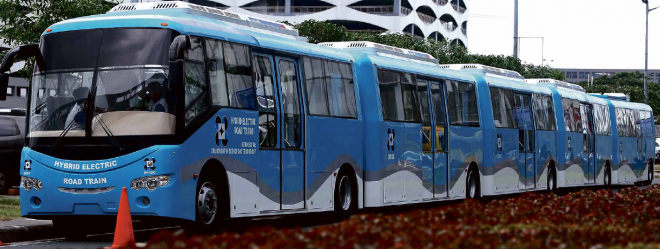
STRETCHED SOLUTION The P45-million road train developed by the Department of Science and Technology (DOST) is a hit attraction during the 2015 National Science and TechnologyWeek held on July 24-28 at SMX Convention Center in Pasay City. It took DOST three years to complete the 40-meter-long vehicle. CHARLES BUBAN
Throughout human history, necessity has driven invention and innovation. With public transportation virtually destroyed at the end of World War II, enterprising Filipinos modified the surplus Willys and Ford military jeeps to develop a public transport system. They removed the jeep’s rear, extended the rear seats so the vehicle could take in passengers and added a metal roof. Thus was born the jeepney.
Fast-forward to the present: With Metro Manila’s traffic condition and air-quality level not getting any better, Filipino engineers at the Metals Industry Research and Development Center of the Department of Science and Technology (MIRDC-DOST) were challenged to create an alternative urban mass transit that would be safe and convenient to ride, not too expensive to build and maintain, burn less fuel and generate less emissions, and not seriously worsen the already problematic traffic situation when introduced into crowded roads of the metropolis.
Three years and P45 million later, the engineers headed by DOST Assistant Secretary Robert Dizon unveiled a working prototype of a hybrid diesel-electric “road train” during the 2015 National Science and Technology Week at SMX Convention Center in Pasay City last week.
The road train is one of the three projects on the DOST’s Advanced Transport Program under the Makina Para Sa Bayan Program or MakiBayan. An automated guideway transit —a driverless, elevated, electric-powered train—and the retrofitting of 40 donated and unused coaches for the Philippine National Railways are the other projects.
“The DOST road train is actually a hybrid of sorts: Just like a train, it has a total of five coaches, is 40 meters long and can accommodate up to 240 passengers. But like buses, the road train moves on wheels,” said Christian Ibañez, a science research specialist at the MIRDC-DOST.
Each road train has 12 wheels, he said.
“Just like Metro Manila’s Light Rail Transit trains, the road train is driven by electric motors. They draw power not from an electric overhead cable but from 260 interconnected lead-acid batteries constantly charged via regenerative braking and by a generator that converts the energy produced by a small conventional diesel engine,” Ibañez said.
No waste
Getting a regular vehicle moving needs a big input of power, and every time the driver hits the brakes all the energy built up disappears again, wasted in the brake pads as heat. In the regenerative braking that the road train employs, this energy that should have been wasted while slowing down or coasting downhill is captured, turned into electricity, and stored in the batteries.
“When the DOST road train slows down or coasts downhill, the same electric motors go into reverse. The electricity that is produced is stored back into the batteries. If battery charge is still low or when more power is needed, the diesel engine paired to the DOST road train’s 300 kVA (kilovolt-ampere) generator kicks in to supply more power. With the technology that we have installed, emissions are significantly lower,” he said.
When asked if the road train could readily be introduced into Metro Manila’s major roads like Edsa and Commonwealth Avenue in Quezon City, Ibañez said the 10-ton vehicle would not require the building of new infrastructure like railway tracks, overhead electric cable system or digging of tunnels.
“With the DOST road train, the requirement would only be the creation of a dedicated lane much like the marked ones the MMDA (Metropolitan Manila Development Authority) created for motorcycles along Edsa and Commonwealth Avenue as well as bus stops that could accommodate the 40-meter length of the vehicle,” he said.
As explained by Dr. Rio Pagtalunan, MIRDC-DOST analysis and testing division chief, the train system is still the most efficient public mass transportation system, the reason why the DOST road train is patterned after a train system model.
For those who wonder how a vehicle this long would be able to turn, Ibañez said the road train maneuvers just like a regular bus and will only need a three-lane-wide road to make a 90-degree turn.
“We have proven this on the parade ground and nearby streets of Clark Freeport in Angeles City, Pampanga, and the roads around SM Mall of Asia in Pasay City. Moreover, there is no special training for the driver as long as that person knows how to drive trucks and buses,” he said.
He added that the electrical and other water-sensitive parts of the road train are raised almost 2 meters, making it safe to drive through flooded roads. For added safety, the batteries and the generator are located in the fifth and last coach, separate from the passenger coaches.
Moreover, for passenger convenience, the lowest steps of the road train are at sidewalk level while the doors are wider by about 2 m than the doors of regular buses or light rail trains.
The road train can accommodate 60 passengers per coach, for a maximum of 240 passengers per trip or 650,000 passengers per day.
As for maintenance, Ibañez said, the parts and components used (generator, batteries, wheels, electrical and body) and technologies employed (regenerative braking and hybrid drivetrain) in the road train are locally developed and sourced.
“For companies that would like to acquire the DOST road train, they would just have to obtain the patents from us,” he said.
The price of the road train is much lower than the P45 million the DOST spent and would only take the MIRDC engineers about six months to fabricate, he said.
RELATED STORIES
Hybrid trains pushed as alternative to ease Metro traffic
PH-made ‘road trains’ go on test run in Clark